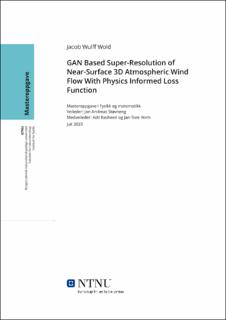| dc.description.abstract | I møte med økende behov for grønn energi er det forventet med stor økning i vindkraftutbygging de neste årene. Billig høyoppløslig vinddata kan hjelpe vindutviklere å optimere produksjon og redusere risiko ved vindutbygging.
For å bidra til dette brukes en konvulær GAN modell her til å øke oppløsningen på mikroskala atmosfæriske vindfelt. Ved å anvende en ESRGAN generator-arkitektur med terrenganalyse og dropout-lag gir modellen en 4x4 økning i horisontal oppløsning på vinddata med 0.24 m/s gjennomsnittlig vektorlengde på feilen, og fysisk rimelige genererte 3D vindfelt.
Modellen brukes på et numerisk generert datasett med irregulære vertikale koordinater. Forskjellige tilnærminger for å håndtere dette koordinatsystemet blir testet. Det best fungerende oppsettet interpolerer dataen så den blir regulær i forhold til bakkenivå, og inkluderer z-koordinater som input til modellen.
Basert på relevant fysikk introduseres og testes flere tapfunksjoner som sammenligner spesifikke deler av vindgradienten til det genererte og høyoppløselige vindfeiltet. Den beste tapsfunksjonen fokuserer mest på, i synkende rekkefølge, forskjeller i ∂x og ∂y-deriverte, horisontal divergens absoluttfeil og divergens. Adversarial læring blir til slutt droppet, da det maks bidro til en liten forbedring.
Den beste modellen presterer betydelig bedre enn interpolering, og anslår til og med tur-
bulente vindmønstre rimelig bra. Modellen er også fleksibel, den kan også brukes til 8x8
og 16x16 økning i horisontal oppløsning. Mer må gjøres før modellen kan anvendes i
utvikling eller drift av vindparker, da modellen må tilpasses relevant skala, terreng og
datasett. Totalt sett er resultatene lovende. | |
| dc.description.abstract | To meet the growing demand for green power generation, wind power development is projected to increase much in the coming years. Computationally cheap high resolution wind data can help wind developers increase production and give better production estimates, thereby reducing both the cost of wind power andthe risk associated with wind farm development.
To help accomplish this, here a fully convolutional 3D GAN with a wind gradient based
loss function is trained to super-resolve microscale near-surface atmospheric wind flow.
Applying an ESRGAN generator architecture with a terrain feature extractor and a feature
dropout layer, the model super-resolves the wind field to 4x4 increased horizontal resolution with average length of the error wind vector 0.24 m/s, and physically reasonable-
looking 3D wind flow.
The model is applied to a generated dataset with unevenly spaced vertical coordinates.Various approaches for addressing the irregular grid are tested, and it is found that interpolating the wind field with regular vertical spacing relative to the ground, and adding terrain as input to the model performs best.
Based on the physics of atmospheric wind flow, multiple loss functions comparing specific
parts of the wind gradient of the generated and the high resolution wind field are introduced
and tested. A loss function focusing on, in descending order, differences in the ∂x and ∂y derivatives, horizontal divergence and divergence, mediated by an average absolute error pixel loss was found to increase performance greatly. Adversarial learning is dropped, as it at best only slightly improved on pure content loss.
The best model is shown to do significantly better than interpolation, even approximating turbulent wind patterns reasonably well. The model is shown to be flexible, also able to produce 8x8 and 16x16 resolution increase. Further work is needed to apply the model in wind farm development or operation, tailoring the model to the relevant scale, terrain and datasets. All in all, the model should be considered a proof-of-concept for CNN driven super-resolution of 3D microscale atmospheric wind flow. | |
